Key takeaways:
- Understanding audience needs through engagement and dialogue fosters a collaborative atmosphere for innovation.
- Choosing relatable and passionate speakers enhances audience connectivity and sparks creative exchanges.
- Fostering open communication and providing constructive feedback creates a safe environment for sharing and growing ideas.
- Celebrating innovative ideas with enthusiasm and incorporating fun elements motivates participants and encourages ongoing creativity.

Understand Audience Needs
Understanding audience needs is crucial for fostering genuine innovation during a presentation. I recall a time when I was invited to attend a tech conference. The speaker initially dazzled the audience with jargon and cutting-edge concepts, but as I observed the crowd, it became clear that many were overwhelmed. Engaging the audience right from the start can set the tone for innovation; if they don’t see themselves reflected in the content, how can we expect them to innovate?
When I engage with an audience, I strive to create a dialogue. I often ask questions like, “What challenges are you currently facing?” This not only breaks the ice but also opens the floor to innovation by allowing the audience to pinpoint their specific needs and experiences. In one workshop, this approach transformed a rigid presentation into a collaborative brainstorming session. It’s fascinating how one question can spark a wealth of ideas and solutions.
It’s essential to remember that innovation doesn’t happen in a vacuum. The more I understand the unique challenges and aspirations of my audience, the better I can provide insights that resonate. I’ve found that sharing personal stories or examples that relate to their experiences can create a sense of connection. When they see how their own struggles mirror mine, it encourages them to think creatively and engage in the process. After all, innovation thrives in an environment that feels safe and connected.
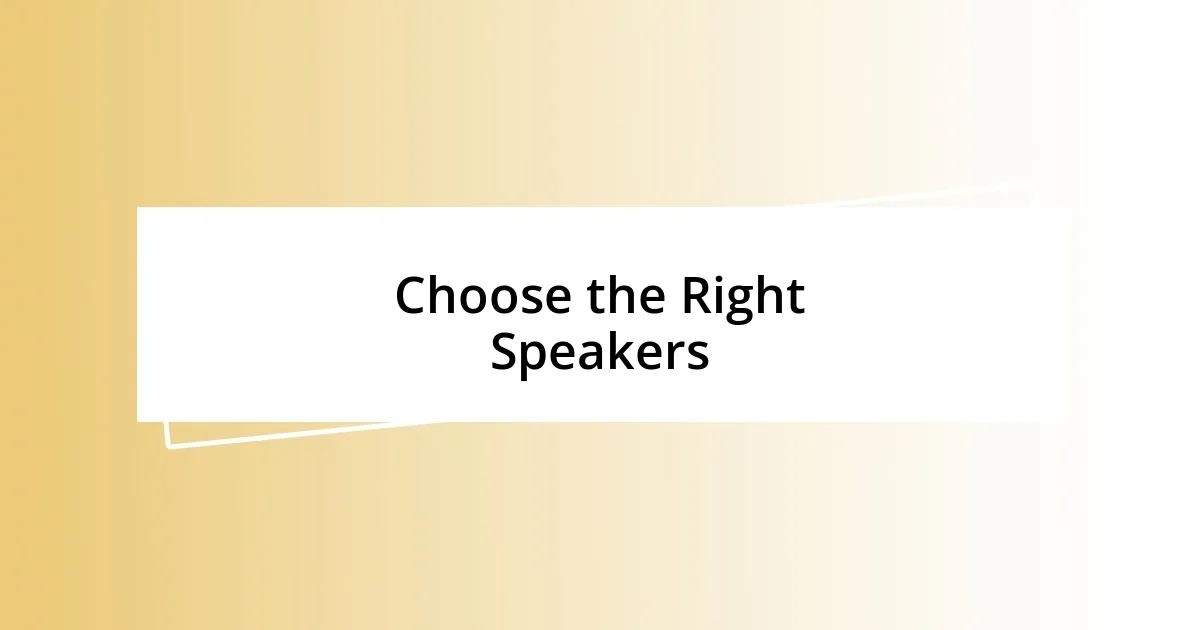
Choose the Right Speakers
Choosing the right speakers is pivotal in setting the stage for innovation. It’s not just about their credentials; it’s about finding individuals who can genuinely connect with the audience. I remember a panel I attended where one speaker radiated enthusiasm. Their energy was contagious, and by sharing relatable stories, they invited the audience into a world of possibilities. By selecting speakers who can spark that kind of energy and foster relatability, you lay the groundwork for dynamic exchanges and innovative thinking.
Here are some key factors to consider when choosing speakers:
- Expertise in the Topic: Look for speakers who possess deep knowledge and practical experience related to your audience’s interests.
- Engagement Skills: Choose those who can captivate and maintain attention, as engagement often leads to innovation.
- Relatability: Select speakers who can share personal stories and experiences that resonate with the audience, making the content more accessible.
- Diversity of Perspectives: Consider a mix of voices to encourage a wider range of ideas and innovations.
- Passion for the Subject: Excitement about the topic can be a powerful catalyst for inspiration and creativity.
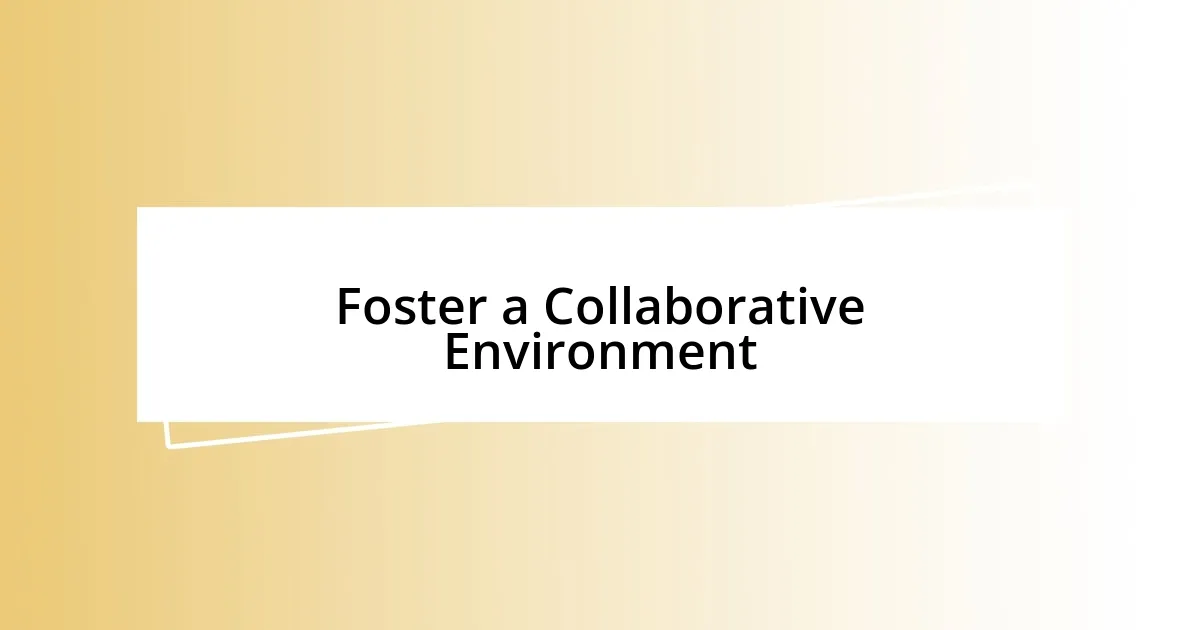
Foster a Collaborative Environment
Fostering a collaborative environment is essential for unleashing innovation. I recall a workshop where we transformed a traditional presentation into a round-table discussion. By rearranging the seating and inviting everyone to share their thoughts, the dynamic shifted remarkably. Suddenly, ideas flowed freely, and collaboration soared, all because we prioritized an inclusive atmosphere over a one-sided lecture.
I’ve found that simple techniques can significantly enhance collaboration. For instance, breaking participants into small groups can encourage quieter voices to share their ideas. In one instance, after brainstorming in pairs, we came back to the main group with a treasure trove of innovative approaches. This structure allows for more diverse perspectives, and it’s fascinating to witness how quickly solutions emerge when people feel comfortable contributing.
Keep in mind that creating a collaborative environment also involves encouraging respect and openness. It’s vital that every participant feels their input is valued. I remember one speaker who adeptly highlighted audience contributions, weaving them into the presentation seamlessly. This not only validated participants but also sparked further dialogue among everyone involved, illustrating how mutual respect amplifies creativity.
| Traditional Presentation | Collaborative Environment |
|---|---|
| One-way communication | Two-way dialogue |
| Passive audience | Active participants |
| Limited idea flow | Rich exchange of ideas |
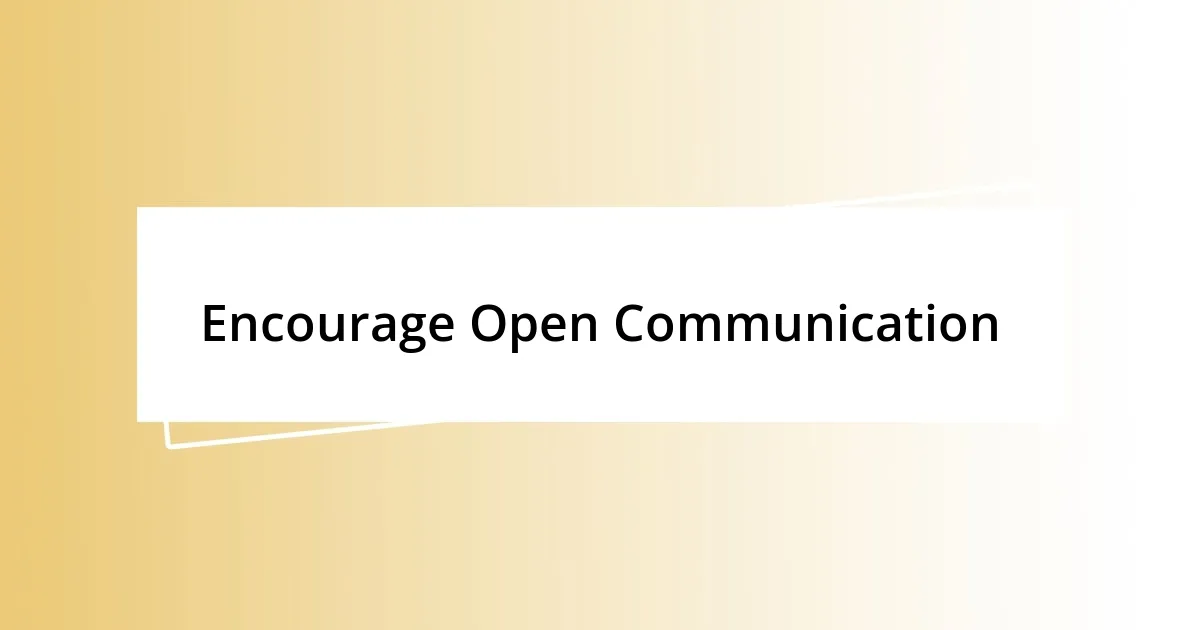
Encourage Open Communication
Open communication acts as a catalyst for innovation, fostering an environment where ideas can flourish. I vividly recall a time when I attended a brainstorming session that felt almost electric. The facilitator made it a point to encourage everyone to voice their thoughts, and in doing so, I found myself contributing ideas that I had initially hesitated to share. This openness transformed the atmosphere; it was no longer just about exchanging information, but rather about building on each other’s insights. Have you ever noticed how sharing an idea can lead to unexpected breakthroughs?
Creating space for candid conversations is critical. One poignant experience I had was during a workshop where participants were encouraged to ask questions freely, even if they seemed simple. I remember someone asking a seemingly straightforward question about a complex concept, and it led to a spirited discussion that demystified the topic for everyone involved. That moment underscored the importance of not just talking but actively listening. It reminded me that every question holds potential; encouraging people to ask, no matter the complexity, opens a floodgate of creativity.
Additionally, I’ve learned that celebrating candidness can significantly enhance open communication. In one event I organized, we created a “kudos” wall where attendees could write down thanks or insights shared by their peers. This small act transformed the energy in the room, encouraging more participants to engage with one another. When people feel appreciated for their contributions, they are more likely to express themselves further. Isn’t it interesting how a small acknowledgment can lead to a much larger dialogue?
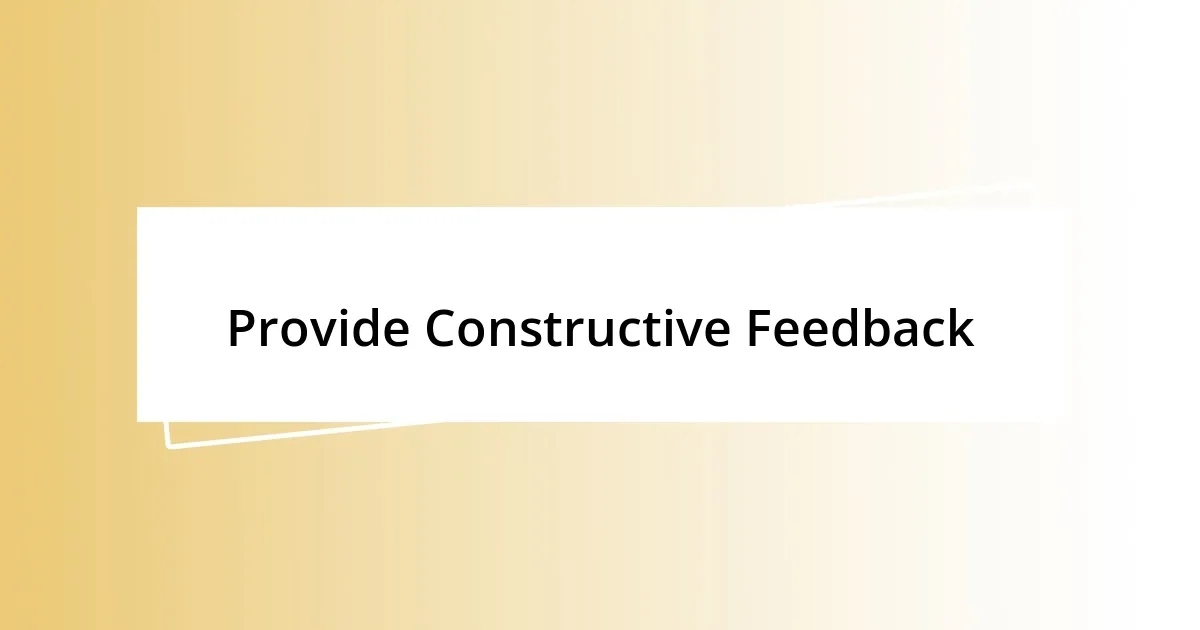
Provide Constructive Feedback
Providing constructive feedback is pivotal in nurturing innovation. I once participated in a feedback session where instead of just pinpointing flaws, the leader highlighted both strengths and areas for improvement. It felt empowering; not only did I leave with a clearer understanding of my blind spots, but I was also motivated to refine my ideas further. Have you ever experienced feedback that ignited your passion?
I’ve realized that specificity in feedback often makes it more meaningful. During a pitch presentation, I shared a project that had potential, but the feedback I received was vague at first. After prompting for specifics, one member highlighted how visual storytelling could enhance my message. This thoughtful critique helped shape my approach significantly. It was a game-changer, one that made me appreciate the value of detailed input from others.
Additionally, creating a safe space for feedback is essential. In one instance, I organized a peer review workshop where each participant committed to giving feedback without any judgment. The atmosphere was electric, and it transformed the way we viewed each other’s work. Witnessing colleagues grow from genuine, non-threatening feedback taught me how we can all improve when we feel safe to take risks. Doesn’t it feel like a revelation when you understand that growth thrives in an environment of trust?
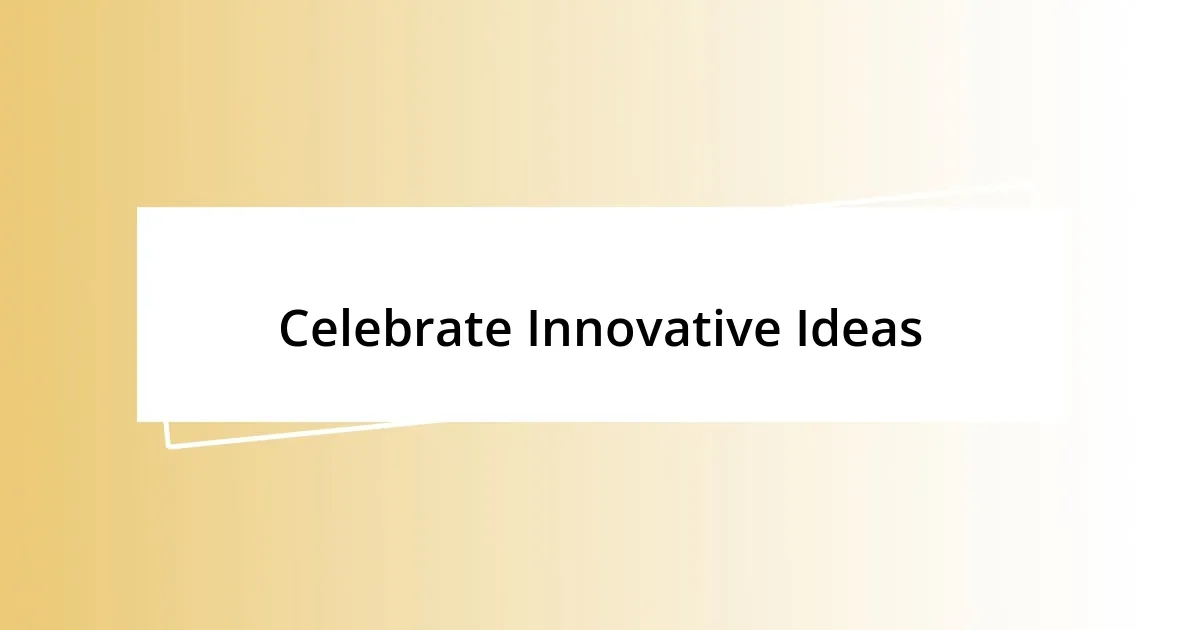
Celebrate Innovative Ideas
Celebrating innovative ideas can truly energize a group. I recall a pitch meeting where the leader not only recognized standout concepts but also encouraged applause and cheers after each presentation. Witnessing that enthusiasm made participants beam with pride, fueling their creativity. Have you ever felt that rush of motivation when your efforts are acknowledged?
I think it’s vital to move beyond the typical “good job” remarks and delve into what makes an idea truly innovative. At a recent tech event, I witnessed a panel where the audience was invited to ask follow-up questions about each proposed idea. The resulting dialogue not only showcased fresh perspectives but genuinely celebrated the innovation in those pitches. That moment reinforced my belief: when we take time to explore and appreciate innovative notions, we uncover hidden gems that could revolutionize processes.
Moreover, incorporating fun elements into the celebration of ideas can leave a lasting impression. During a workshop I led, we introduced a “Shark Tank” style segment where participants could pitch to a jury of peers. We applauded not just the winners but everyone who dared to present. The energy in the room was infectious, and I could see that many walked away inspired. It made me think—how often do we prioritize the act of presenting over the celebration of creativity? This shift in focus can foster a thriving culture of innovation.
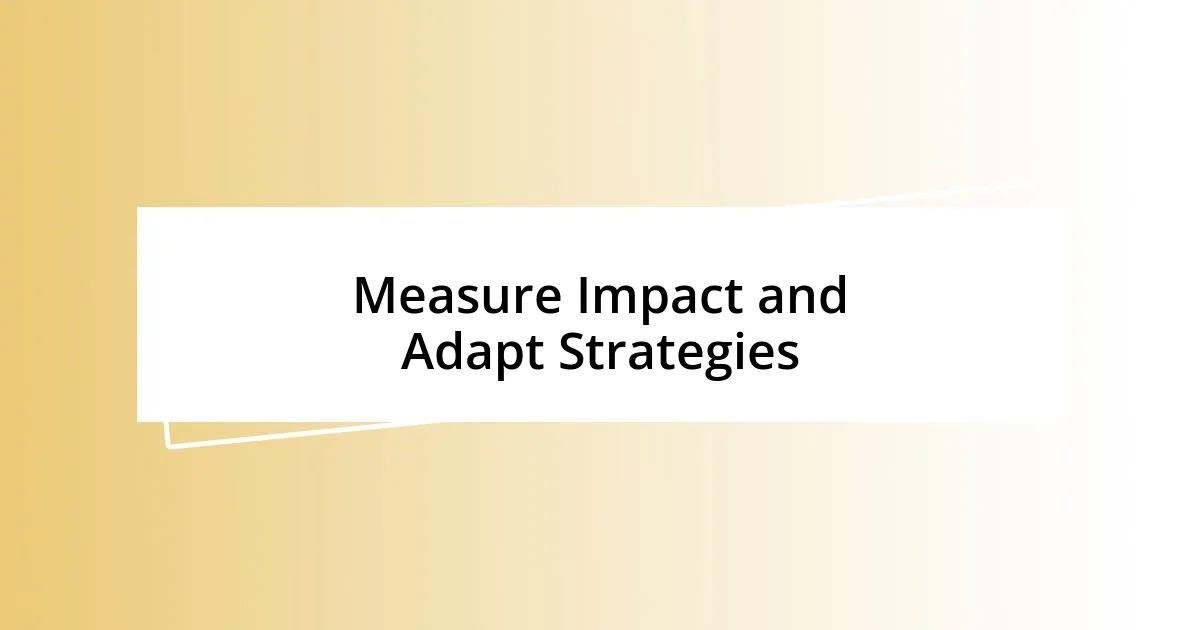
Measure Impact and Adapt Strategies
Measuring impact isn’t just about numbers; it’s about understanding the real shift in thinking and behavior that takes place after presentations. I remember a time when I implemented a post-event survey after a series of speakers. The feedback revealed not just what resonated, but also how the audience planned to apply the ideas shared. Isn’t it fascinating how a well-structured evaluation can reveal insights we might overlook in the moment?
Adapting strategies based on measurable outcomes can lead to remarkable improvements. For instance, after noticing that certain topics sparked lively discussions while others fell flat, I adjusted our speaker selection to align with audience interests. This not only increased engagement rates, but I could actually feel the energy in the room shift. Have you ever seen a simple change lead to a significant transformation in your work environment?
Moreover, I soon realized that innovation thrives in an environment of continuous learning. I began tracking not just the immediate responses but also the long-term effects of our speakers on individual projects. When a speaker introduced a groundbreaking strategy, I made it a point to follow up months later to see how teams had integrated those ideas. It reinforced my belief that measuring impact isn’t just a one-time affair; it’s a systematic approach that fosters enduring growth. What about your experiences—how do you measure the real impact of inspiration?












